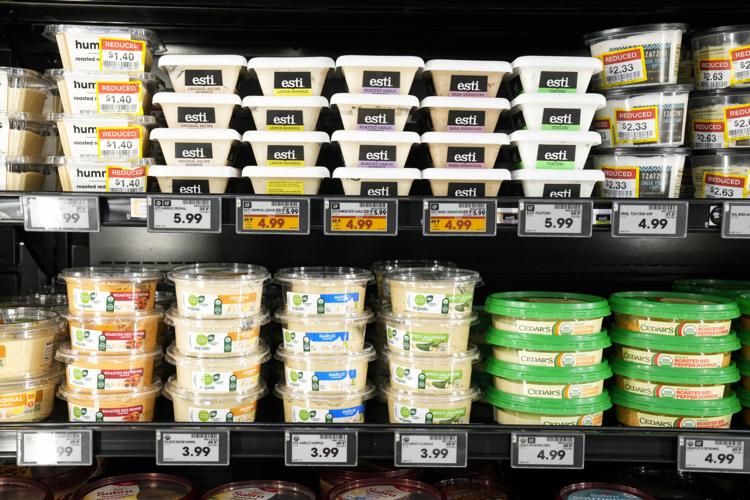Digital price labels, which are rapidly replacing paper shelf tags at U.S. supermarkets, haven’t led to demand-based pricing surges, according to a new study that examined five years' worth of prices at one grocery chain.
But some shoppers, consumer advocates and lawmakers remain skeptical about the tiny electronic screens, which let stores change prices instantly from a central computer instead of having workers swap out paper labels by hand.
“It’s corporations vs. the humans, and that chasm between us goes further and further,” said Dan Gallant, who works in sports media in Edmonton, Canada. Gallant's local Loblaws supermarket recently switched to digital labels.

Electronic grocery labels are displayed at a Kroger grocery store in Monroe, Ohio.
Dynamic pricing strategy
Social media is filled with warnings that grocers will use the technology to charge more for ice cream if it’s hot outside, hike the price of umbrellas if it’s raining or to gather information about customers.
People are also reading…
Democratic U.S. Sens. Elizabeth Warren of Massachusetts and Bob Casey of Pennsylvania fired off a letter to Kroger last fall demanding to know whether it would use its electronic labels as part of a dynamic pricing strategy.
Lawmakers in Rhode Island and Maine have introduced bills to limit the use of digital labels. In Arizona, Democratic state Rep. Cesar Aguilar recently introduced a bill that would ban them altogether.
The bill hasn’t gotten a hearing, but Aguilar said he’s determined to start a conversation about digital labels and how stores could abuse them.
“Grocery stores study when people go shopping the most. And so you might be able to see a price go down one day and then go up another day,” Aguilar said.

Electronic grocery labels are displayed at a Kroger grocery store, in Monroe, Ohio, Nov. 13.
Digital labels are safe, researchers say
Researchers say those fears are misplaced. A study published in late May found “virtually no surge pricing” before or after electronic shelf labels were adopted. The study was authored by Ioannis Stamatopoulos of the University of Texas, Austin, Robert Evan Sanders of the University of California, San Diego and Robert Bray of Northwestern University
The researchers looked at prices between 2019 and 2024 at an unnamed grocery chain that began using digital labels in October 2022. They found that temporary price increases affected 0.005% of products on any given day before electronic shelf labels were introduced, a share that increased by only 0.0006 percentage points after digital labels were installed.
Economists have long wondered why grocery prices don’t change more often, according to Stamatopoulos. If bananas are about to expire, for example, it makes sense to lower the price on them. He said the cost of having workers change prices by hand could be one issue.
But there’s another reason: Shoppers watch grocery prices closely, and stores don’t want to risk angering them.
“Selling groceries is not selling a couch. It’s not a one-time transaction and you will never see them again,” Stamatopoulos said.

Electronic grocery labels are displayed at a Kroger grocery store, in Monroe, Ohio, Nov. 13.
Electronic price labels aren’t new. They’ve been in use for more than a decade at groceries in Europe and some U.S. retailers, like Kohl's.
But they’ve been slow to migrate to U.S. grocery stores. Only about 5% to 10% of U.S. supermarkets now have electronic labels, compared to 80% in Europe, said Amanda Oren, vice president of industry strategy for North American grocery at Relex Solutions, a technology company that helps retailers forecast demand.
Oren said cost is one issue that has slowed the U.S. rollout. The tiny screens cost between $5 and $20, Oren said, but every product a store sells needs one, and the average supermarket has 100,000 or more individual products.
Still, the U.S. industry is charging ahead. Walmart, the nation's largest grocer and retailer, hopes to have digital price labels at 2,300 U.S. stores by 2026. Kroger is expanding the use of digital labels this year after testing them at 20 stores.Â

Electronic grocery labels are displayed at a Kroger grocery store, in Monroe, Ohio, Nov. 13.
Supermarket chains tout benefits
Companies say electronic price labels have tremendous advantages. Walmart says it used to take employees two days to change paper price labels on the 120,000 items it has in a typical store. With digital tags, it takes a few minutes.
The labels also can be useful. Some have codes shoppers can scan to see recipes or nutrition information. Instacart has a system in thousands of U.S. stores, including Aldi and Schnucks, that flashes a light on the digital tag when Instacart shoppers are nearby to help them find products.
Ahold Delhaize’s Albert Heijn supermarket chain in the Netherlands and Belgium has been testing an artificial intelligence-enabled tool since 2022 that marks down prices on its digital labels every 15 minutes for products nearing expiration. The system has reduced more than 250 tons of food waste annually, the company said.




















